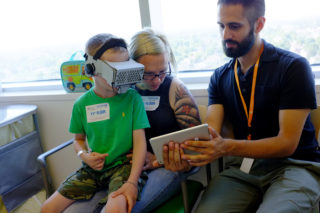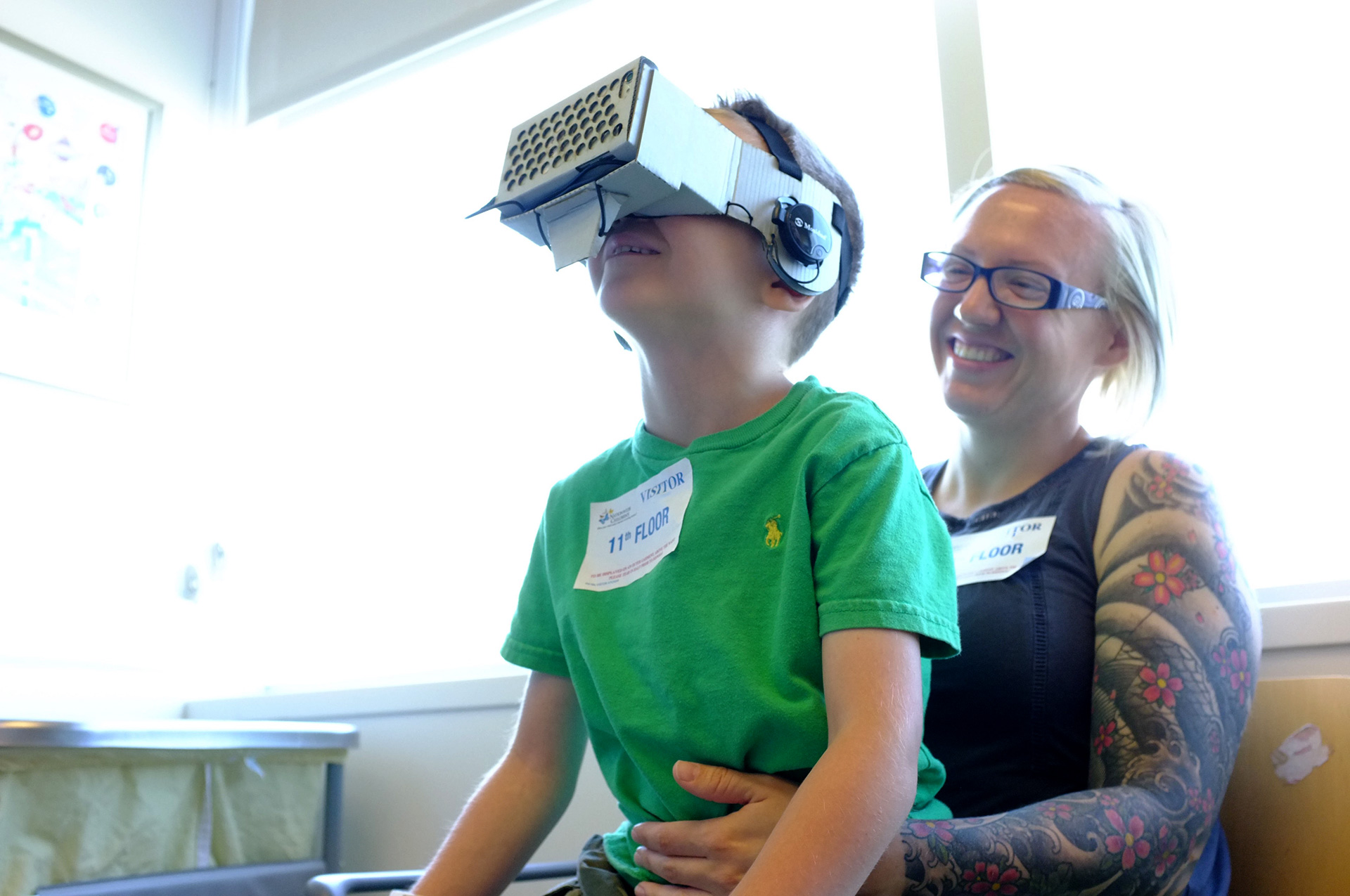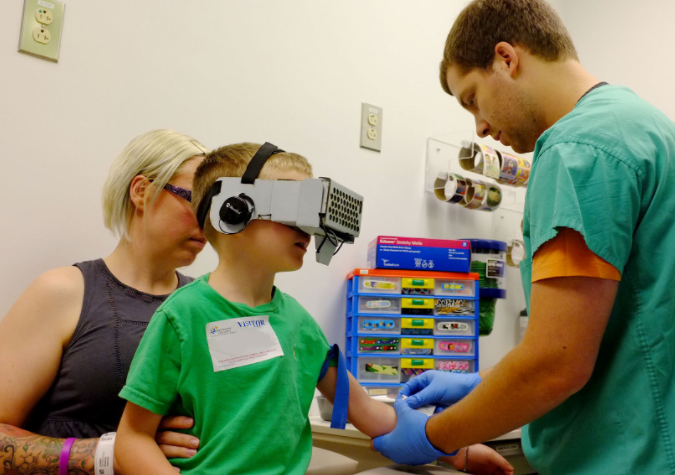Virtual reality is working its way into the mainstream in surprising ways, but one day kids may want to visit an unlikely place for a unique game experience: the doctor’s office. Nationwide Children’s Hospital is conducting a study to help kids with hemophilia overcome the pain and anxiety that can come with receiving regular treatments such as injections. The study involves a VR game called Voxel Bay, which was developed by the hospital and is played on mobile devices.
Created using the Unity Engine, Voxel Bay takes inspirations from Minecraft and Nintendo’s collection of games to help sooth children as they are being treated. The kids interact with the experience by moving their head around and blowing into the microphone to complete different challenges. Voxel Bay was a finalist at the SXSW Interactive Innovation Awards in the category of health, med and biotech and is the brainchild of Jeremy Patterson, the lead of user experience technology research and development at the Nationwide Children’s Hospital Research Institute. He worked with John Luna, a graduate intern at Nationwide Children’s Hospital and MFA candidate at Ohio State University, who was instrumental in designing the experience.
While discussing the inspirations for Voxel Bay, Patterson told [a]listdaily that Nintendo games, particularly ones on the Wii console, helped shape the experience. “Nintendo games are great because they’re not non-gender specific,” he said, “but they’re good for any age group.”
Luna added, “kids are the harshest critics. If it’s not fun, you’ll know immediately.
Patterson and Luna talk about how the project came together and how VR could one day become a routine part of patient care.
How did the idea for the Voxel Bay VR experience come together?
[Patterson]: There was one morning that I came into work and got called over to an impromptu meeting with someone who had just started with the organization. It turns out that the person I was meeting with was Dr. Amy Dunn; she’s the head of hematology here Nationwide Children’s. She had a lot of questions about fairly novel things that we could try to build to help the patient population face their dilemmas.
Kids with hemophilia have a unique set of problems, and one of them is needle phobia. They might develop needle phobia if they have a bad experience with their infusions. If they develop that, it hurts their long-term care because they can’t refuse treatment. They end up having to get a port put in, and then it snowballs and becomes more problematic.
So, we started brainstorming about things that we could do, and I had known about how effective VR was for pain relief and management. It seemed to me that VR was effective at putting people into a different context, almost like the way a person can meditate—they’re not necessarily aware of their surroundings or pain. They’re also not going to be as anxious or nervous. From that, we started down the path of creating something that we could use in clinics. The research had been around for years, but the big win for us was getting it into clinics to start helping patients now.
That’s what we’ve been working on for the past couple of years. It has been in clinic and we’ve been seeing it help people. It’s very effective.
How does VR compare to using traditional mobile games to help distract patients during procedures?
[Patterson]: One of the things that we found early on was that there are clinics where people use games on iPads to distract patients. Those work very well, but the dilemma that we faced was that this was for kids who are receiving infusions. They need to be seated, stationary and still. They can’t play a game on an iPad or a traditional game using a controller because their hands can’t move. That’s when we had to find a different way for them to not only be engaged in a virtual environment but interact with the games too. That’s where John stepped in, and he had a lot of good ways to deal with that problem.
[Luna]: We did a lot of game space controls because they just made sense. You have the gyroscope driving the camera, so why not use it to further immerse the player? We also looked into using the microphone as an input device. There are some games where the kid has to blow crabs across a little expanse, Angry Birds-style. The microphone is great because we can encourage kids to breathe in a steady rhythm, calms them down and provides them with a physical activity that connects them to these virtual spaces without relying on haptic feedback. It furthers the illusion of the virtual immersion.
What do the kids experience in the VR space?
[Luna]: It’s a pseudo pirate adventure. They’re sailing the seven seas, traveling from one island to another, where they encounter little creatures that give them quests—mini-games—for them to play. They could be running from pirates, recovering stolen treasure, hunting forest spirits or floating up to trees to deliver packages. One of my favorite ones is a game where they’re trying to help a momma penguin get to her babies, which are being barked at by a big seal.
[Patterson]: We’ve been avid gamers for years. So, the main experience of sailing around the islands is an homage to The Legend of Zelda: The Wind Waker. We try to bake in the things that we enjoy as much as possible.
How did the kids and parents involved with the study react to adding VR to their treatment?
 [Patterson]: We just concluded all the patients that were in the study, so no data has been published yet, and we can’t say anything for certain. But from seeing people’s reactions—there are some kids who want to see the procedure done and don’t want anything to get in their way. For those kids, we don’t force anything different on them. But there have been a lot of kids who, when trying to infuse them and give them shots, were very difficult. We only found this out after seeing them without the VR headset, because they were fine when they were with us. In one case, the parent was a medic, and she had problems administering care to her son. But with this headset and VR experience, it’s totally different. He smiles and laughs.
[Patterson]: We just concluded all the patients that were in the study, so no data has been published yet, and we can’t say anything for certain. But from seeing people’s reactions—there are some kids who want to see the procedure done and don’t want anything to get in their way. For those kids, we don’t force anything different on them. But there have been a lot of kids who, when trying to infuse them and give them shots, were very difficult. We only found this out after seeing them without the VR headset, because they were fine when they were with us. In one case, the parent was a medic, and she had problems administering care to her son. But with this headset and VR experience, it’s totally different. He smiles and laughs.
The other thing that we found, which we weren’t expecting, was how much relief it offered the parents. The parents like it because they’re not seeing their kid in distress, and they can also see what their kid is doing, which is a good distraction for them.
[Luna]: With the setup we have right now, the parents can be part of the experience. They can watch on a separate unit to see what the kid is doing and talk to them. So, it’s not the typical VR experience, where the people in the room are basically cut off from the player. Parents can still be part of the experience without having to put on a set of goggles.
I’ve only been here for a couple of years, but one of the things that I’ve learned about health care is that it’s not about finding a one-size-fits-all solution. You find what helps a percentage of the patient population, and if you can make their experience better, then you’ve done your job. It may not work for everybody, just like VR might not necessarily be for everybody, but if it works for some people then it’s a success.
How closely do you think VR and video games will be integrated with patient care in the future?
[Patterson]: I think it’s going to be very pervasive over the next few years. We’re already starting on some new initiatives that have spun off from our Voxel Bay work. I’m not going to speak to openly about them, but suffice it to say that after people started catching wind of the effect Voxel Bay was having, there were a lot of people from different departments who came to us to say, “hey let’s start rolling it out here. Let’s figure out a way for us to use it in our clinic.”
Each Clinic is like a unique snowflake. They do things differently, and there are different considerations. Now it’s a process of how we can integrate into all these different cases.
What other forms of health care could benefit from using VR?
[Patterson]: Almost all of them. My opinion is that whenever somebody steps into the hospital, it could be helpful to them, but one of the natural ones is dentistry. It’s a natural fit, and it’s just an example of one area that could be a good next step.

Would you consider releasing Voxel Bay on the open market for kids to play at home?
[Luna]: Maybe as a different version, because you want the experience to be unique. If you play Mario all the time at home, going to the doctor’s office to play it won’t have the same effect.
[Patterson]: We want to get it out there, but we’re still figuring out how we’d like to handle that in the future. Maybe it’ll be locational so that you’ll get a different set of experiences at home, but coming to the doctor’s office could unlock content you can’t get at home.
Do you that with VR, kids will eventually look forward to going to the doctor’s office?
[Patterson]: I totally see a day when this will be as ubiquitous in doctors’ offices as magazines. The worst case scenario is when a kid is crying and doesn’t want to be in the doctor’s office. But seeing them come in smiling, laughing and having fun is a completely different ballgame. We’ve seen that happen. We had one kid ask his mom to give us $5,000 for the headset, which we clearly didn’t do, but it’s about moving the ball forward. If we can make something slightly better, why shouldn’t we do that? It might not make it fun all the time, but making that one moment better for somebody is worth it.

